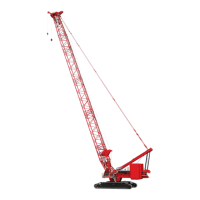Manitowoc Published 05-26-17, Control # 238-02 5-5
MLC165-1 SERVICE/MAINTENANCE MANUAL HOISTS
Drum Pawl
The drum pawls are controlled by node 4 voltage, the drum
pawl directional control valves, and the park switches in the
cab.For pawl operation see:
Drum 1 Pawl
on page 5-29
Drum 4 Pawl on page 5-31
Operation on page 5-32
Drum Motors
See Figure 5-3 on page 5-6.
Drum 1 and Drum 2 Motor
Drums 1 and 2 are driven by variable-displacement motors.
(See Motor Displacement Control below).
Provision for motor cooling is not required. Normal working
flow is sufficient for cooling.
Motor Displacement Control (MDC) Solenoid Valve
Motor displacement is varied by the MDC solenoid valve
acting on an internal hydraulic actuator. The actuator is
controlled by the solenoid until the system pressure reaches
the setting of the pressure compensated override (see
PCOR below).
When the control handle is in the center position, the motor is
at maximum displacement (high torque, low speed). When
the control handle is moved off center, the control system
outputs a proportional voltage signal (4.5–10Vdc) to the
MDC valve’s solenoid, which shifts the valve’s spool in
accordance with crane programming. The valve spool shifts
to allow flow to or from the actuator, which moves the
swashplate. The valve spool is also mechanically connected
to the actuator by a spring.
Control input for the control signal is the 1–5Vdc from the
pressure transducer. An electronic pressure compensator is
used to maintain a maximum displacement of 260 bar (3800
psi).
The solenoid coil normally draws 200mA–600mA at 68°F
(20°C), with coil resistance nominally 22.7 ohms.
Time Delay orifice—An orifice in the flow to the MDC
actuator dampens the response time of the actuator, and by
extension, dampens motor response to changes in control
handle position and load. This helps dampen any abruptness
in motor operation during changes in control handle position.
The orifice will restrict flow in and out of the servo chamber,
resulting in lag in both directions.
Pressure Compensation Override (PCOR)
The PCOR ensures that the motor delivers sufficient torque
when required. When working pressure (a reflection of load)
reaches 4,000 psi (275 bar), the PCOR begins shifting the
control actuator toward maximum displacement. It does this
by using the working pressure to shift the spool, which
redirects to tank the pilot circuit that supplies the barrel end
of the actuator. This causes the actuator to retract, moving
the swashplate for a larger displacement.
The valve is fully open at the maximum system pressure.
Counterbalance with Pilot-Operated Relief
Attached to the motor is a counterbalance proportional valve
to which the working pressure hoses are connected. The
purpose of the valve is to:
• Ensure that the hoist powers down
• Hold the load when the control handle is in center
• Ensure smooth start, stop, and changes in hoist speed
• Relieve momentary excess pressure that may occur
when bringing a heavy load to a quick stop.
The valve functions differently in each direction:
Lowering and holding a load—When flow is in the lowering
direction, the counterbalance valve functions as a
hydraulically operated proportional spool valve which checks
motor outflow in one position and in the other position allows
motor outflow.
When there is no working pressure (handle in center), a
check valve halts hydraulic flow in the return side of the
down circuit. This prevents the hoist motor from turning in
the down direction. As the control handle is moved off-
center in the up direction, the working pressure begins to act
on the valve, which begins to shift to the unchecked position
to allow motor outflow.
When the control handle is moved toward center, the
counterbalance valve begins to close, slowing the load. At
center, the check valve is again closed, preventing motor
outflow and downward movement of the load.
An orifice in the unchecked circuit prevents abruptness in
starting and changes in hoist speed.
Pilot-operated relief valve—This relief valve protects the
motor from excessive pressure, such as might occur when
bringing a heavy load to a quick stop when lowering. The
valve is factory set to 5,800 psi (400 bar).
Raising a load—When system flow is in the up direction,
the counterbalance valve remains in the unchecked position
and has no effect on operation.
